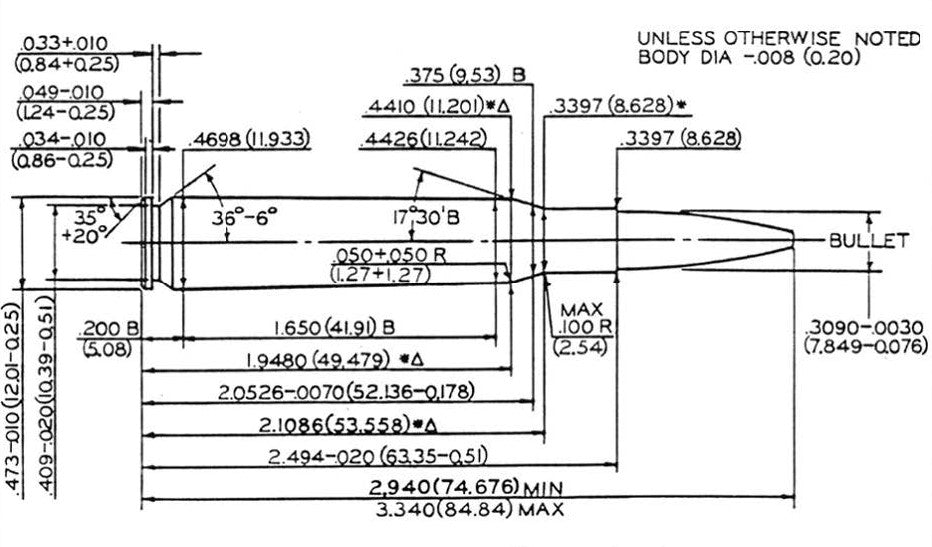A Fall From Grace?
Over the last few years, shooters within the long-range community couldn't help but notice a certain fall from grace from a well-known cartridge: the 0.308 Winchester. The 0.308 Winchester was first developed in the early 1950s, since then it became the most popular short-action hunting cartridge worldwide. Although, it can be argued that among today's options, the cartridge underperforms and is old, outdated, and obsolete. The 0.308 Winchester may be fast becoming ballistically inferior to many modern options, but I'd suggest that in certain scenarios, this old faithful still has a seat at the table.
That's not just an old crusty sniper talking, although I do know the ballistics like the back of my hand. Some newer cartridges and bullet options might have superior ballistics on paper, but the 0.308 Winchester holds its own under a number of practical considerations, and that this old friend may not be so ballistically incompetent as it seems.
So read on, you might glean some practical considerations!
From The Top
When discussing rifle builds and chambering options, the common thread usually favors something regarding 6 or 6.5mm bullet/cartridge combinations for their sleek low drag bullet options and elevated muzzle velocities. But I suspect the internal, external, and terminal ballistics capabilities of the 0.308 Winchester have been overlooked too quickly.
First, let's broadly define and summarize the typical ballistics comparison metrics when discussing ballistic efficiency and performance. In short, achieving superior LR ballistics is about sending the heaviest, lowest drag, highest ballistic coefficient (BC) bullet at the fastest safe launch velocity. Hence the shift towards other caliber and cartridge options. All the while achieving the tightest shot-to-shot consistency (MV and BC) and precision (grouping) possible. With that in mind, let's take a look at a few popular caliber and cartridge combinations.
Ballistics Comparison
The following table presents a comparison of different bullet weights and calibers launched at various muzzle velocities. The muzzle velocities correspond with the appropriate velocity for that bullet weight and cartridge. The cartridges modelled in sequential order are 0.223 Remington, 22 Creedmoor, 6mm Creedmoor, 6.5mm Creedmoor, and 0.308 Winchester. Arguably, the specific cartridges are somewhat irrelevant because we long-range wizards are mostly interested in the performance of different bullets at different velocities. Amongst other things, cartridge selection is one of the consideration factors to achieve a desired muzzle velocity and ballistic performance. Therefore, we need to focus on caliber bullet options and the expected muzzle velocity.
The most glaringly obvious thing that stands out is the horrendous performance of the 77gr bullet at 0.223 Remington launch velocities when compared to any of the other bullets and cartridge velocities. The cartridge is somewhat popular for certain target shooting disciplines so don't fully discount it for everything, but for dynamic long-range - this isn't it.
The next immediately obvious thing to note is the outperformance of most of the 0.308 Winchester combinations. Sure, the 22 Creedmoor, 6mm Creedmoor, and 6.5 Creedmoor comparisons all outperform the 0.308 Winchester combinations in almost all areas. But we already knew this was probably going to happen. What we really need to be discussing is the competitiveness of the 0.308 Winchester against the ballistically superior comparisons, and the pros/cons of each cartridge option despite the inferior ballistics of the 30 caliber bullets at 0.308 Winchester velocities. The analytical numbers sometimes look better on paper, until you factor in real-world shooting considerations. Running the numbers on a ballistic solver quickly analytically defines ballistic performance, but let's take a look at some practical considerations...
A 105gr 6mm bullet could certainly be launched at ~3000fps while easily achieving superior ballistics overmatch when compared to the 0.308 Winchester. However, the bore is going to suffer more throat erosion over a reduced round count. The 22 Creedmoor typically suffers an even worse barrel life. The 0.308 Winchester is known to enjoy less barrel wear and a longer barrel life with an increased round count when compared to a lot of the more efficient bullet/cartridge options. This translates to more overall time behind the weapon system before rebarreling becomes necessary. The fact is a greater barrel life allows for extra range practice and matches before the round-count causes excessive barrel wear and degradation of BC. Sure, some shooters may argue a "trainer" gun in a different chambering mitigates this but that defeats the practical purpose of having a gun you can use for both training and gameday. Remember, gameday isn't a friendly competition for some shooters, it could be on a two-way range. In some instances a trainer gun will be a better option, but extended barrel life equates to more range time and opportunity to truly understand how the gun/ammunition is performing before you start from scratch again after rebarreling.
Another practical consideration is the wealth of knowledge and handloading information available for the 0.308 Winchester. I mainly attribute this aspect to the PALMA and FTR community. The target rifle community has been using 0.308 Winchester handloads for a considerable amount of time and know the performance metrics like no other collective group of shooters in any other discipline. For the average shooter, this information crosses over to easy load development, tight velocity spreads, and exceptionally small groups with just a little research and effort. It's true that the 0.308 Winchester is a very easy cartridge to handload!
The most obvious yet probably most overlooked consideration is the availability of components and loaded ammunition:
- Can loaded ammunition be found at the local gun shop should something go wrong with your handloads?
- Can components such as bullets and cases be found in gun stores across the country should another ammo crisis hit like the last one we all just suffered circa 2020?
Some of these more efficient cartridges such as 6.5 Creedmoor are slowly making their way onto gun shop shelves across America and the world, but it's still a consideration nonetheless. You could have the most accurate and precise gun available, but really it's just an expensive doorstop if you can't get ammunition or handloading components for it!
While we are on the subject of ammunition availability, I should also point out that 7.62x51 NATO has probably one of the largest payload offerings across all small arms cartridges and calibers. That's not the same as 0.308 Winchester you say! Yes, but although there's some slight dimensional differences between the two, 7.62x51 NATO can still be used. This ammunition interoperability lends to a diverse offering of ammunition types designed for very different applications. Militaries around the world have been chambering machine guns and rifles in 7.62x51 NATO for several decades. The result of this is the development of payloads such as armor piercing (AP), barrier blind, subsonic, law enforcement, counter-terrorism, ball, tracer, sniper match, and frangible. A system chambered in 0.308 Winchester might be a good choice if you're concerned about the zombie apocalypse...
Going Terminal
An energy comparison is one of the last considerations we need to discuss. The table below displays the various remaining kinetic energy (KE) and velocity metrics for each bullet and cartridge combination. Let's break this down a little because there's a lot of numbers (and bullets) flying around at this point. We can see that the 77gr is still struggling to keep up with the heavier calibers and lacks any practical KE at this range. The downrange kinetic energy performance progressively increases with the caliber and bullet weight despite the inferior external ballistic performance we discussed in the previous analysis. What we should be deducing from this is that only the heavier caliber bullets will retain the downrange kinetic energy required to drop the hammer on various game types at further ranges. The smaller and more efficient calibers ballistically outperform the 0.308 Winchester until we consider the matter of downrange energy. Even if you're not involved within hunting or government/military applications, the additional kinetic energy helps to identify bullet impacts and splash at greater dynamic engagement distances. The crossover is an increased probability of observing bullet placement downrange for a correction and follow-up reengagement.
The felt recoil of the 0.308 Winchester is typically greater than the more nimble 22 caliber, 6mm or 6.5mm cartridges. This is a practical tradeoff which requires the shooter to weigh the pros and cons before selecting the appropriate cartridge option for the job. The 0.308 Winchester recoil may translate to a little more follow-through time between shots, yet the heavier 30 caliber bullets have a retained velocity and kinetic energy advantage over the smaller bullet/cartridge options. There are many factors involved with terminal ballistics and one of these is kinetic energy. Bullets will normally require an amount of kinetic energy at range to perform terminally as intended. Some bullets may lack the kinetic energy to create any real tissue damage despite a terminal bullet design. Other bullets may lack the terminal design characteristics but retain a kinetic energy advantage which helps to achieve the desired terminal effect on target. This is one of those "fork in the road" moments where the shooting objective and max engagement range must be considered during bullet selection. The more efficient bullets and cartridges might be a better option for punching holes in paper or ringing steel, but other tasks requiring greater KE may be better suited for the 0.308 Winchester.
A final consideration is the state and local government mandates for minimum kinetic energy requirements when hunting different game animals.
The Takeaway
Don't believe everything you hear on the firing line without running your own ballistic analysis. The 0.308 Winchester is very capable for many shooting applications despite being ballistically inferior to various caliber and cartridge options. Like that guy who smokes two cigarettes and pounds a Red Bull® right before a military PT test, the 0.308 Winchester may not outperform, but it can definitely keep up.
The 0.308 Winchester is a great option when kinetic energy in a short action cartridge is required. It really is a do-it-all cartridge. There may be better options out there for specific applications but the 0.308 Winchester can tick a lot of general application boxes. Like a jack of all trades, it doesn't do any one thing exceptionally, but it does have the versatility to do many different things well. Sometimes you just need a sledgehammer rather than a scalpel!
Thanks for joining me on another dive into the world of long-range shooting. If you enjoyed this content, be sure to subscribe, share, and follow us on YouTube, Facebook, and Instagram.

